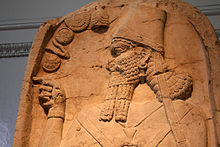Stela of Shamshi-Adad V
| Stela of Shamshi-Adad V | |
|---|---|
 The Stela of Shamshi-Adad V | |
| Material | Limestone |
| Size | Height 195.2 cm, Width 92.5 cm |
| Created | 9th century BC |
| Present location | British Museum, London |
| Identification | ME 118892 |
The Stela of Shamshi-Adad V is a large Assyrian monolith erected during the reign of Shamshi-Adad V. The stela was discovered in the mid nineteenth century at the ancient site of Kalhu (now known as Nimrud) by the British archaeologist Hormuzd Rassam. Dated to between 824-811 BC, the sculpture is now part of the British Museum's collection of Middle East antiquities.[1][2]
Discovery
This stela was found by Rassam in 1855 near the Temple of
White Obelisk of Ashurnasirpal I
.
Description

The stela portrays the Assyrian King worshipping five gods in a format very similar to the
Ishtar in the form of a star. A large amount of cuneiform
text written in an earlier, obsolete style covers the sides of the stela, recording the king's military campaigns.
References
- ^ British Museum Highlights Archived 2015-05-19 at the Wayback Machine
- ^ British Museum Collection
Further reading
- J.E. Reade, Assyrian Sculpture (London, The British Museum Press, 1998)
- A.K. Grayson, Assyrian Royal Inscriptions (Wiesbaden, O. Harrassowitz, 1976)
- J.E. Curtis and J.E. Reade (eds), Art and empire: treasures from (London, The British Museum Press, 1995)
- A.H. Layard, Discoveries in the ruins of Nineveh and Babylon (London, J. Murray, 1853)
